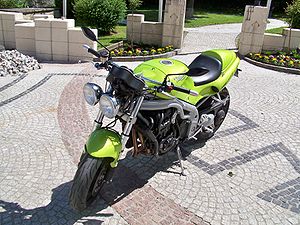Speed Triple

1998 Triumph T509 Speed Triple
|
|
| Manufacturer | Triumph |
|---|---|
| Production | 1994-present |
| Class | Streetfighter |
| Engine | 1,050 cc Triple |
| Power | 140 hp (100 kW) (claimed) |
| Torque | 82.6 lb·ft (112.0 N·m) (claimed) |
| Frame type | Aluminum twin-spar |
| Brakes | Front: Dual 320 mm discs with dual radial-mounted four-piston Brembo calipers Rear: Single 255 mm disc with twin-piston Nissin caliper |
| Wheelbase | 1,450 mm (56.9 in) |
| Seat height | 830 mm (32.5 in) |
| Weight | 192 kg (423 lb) (dry) 212 kg (467 lb) (wet) |
| Fuel capacity | 15.5 L (3.4 imp gal; 4.1 US gal) |
The Triumph Speed Triple is a series of motorcycles produced by Triumph Motorcycles. In 1994 the reborn Triumph became one of the earliest adopters of the new streetfighter style. This was essentially a modern sport bike or race replica motorcycle but without the aerodynamic plastic fairing.
The new bike was first released to the public in 1994, and in a nod to the 1938 Speed Twin, was dubbed the "Speed Triple". The original Speed Twin was powered by a 498 cc vertical twin cylinder engine, and was considered a high performance machine in its day. The new Speed Triple was based on the new Triumph Triple series of modular engines, which also powered the standard Trident, Daytona sport bike, and the Thunderbird retro bike. This engine came in two displacements as a triple: 750 cc for some European markets, and 885 cc for all other markets. The Speed Triple originally was equipped only with the 885 cc engine, but just before significant changes to the bike were made in 1997 a very few 750 machines were produced using leftover Euro specification engines.
Early Speed Triples were all carbureted, and were designated T300 series bikes (Technically, T309). 1994/1995 models came with the standard 885 cc water-cooled engine and a rugged five-speed transmission. Subsequent Speed Triples all had the same engine with six speed transmissions, except for the brief run of 750 cc bikes. As with all the modular Triumphs, the T309 series Speed Triple had a very large single steel tube backbone frame, and used the engine as a stressed member. Forks were 43mm multi-adjustable Kayaba units and the same Japanese firm's shock could be set for preload and rebound damping. Kayaba (now known as KYB) had had a special relationship with Hinckley Triumph from its earliest days. At the rear was a single monoshock with a progressive linkage, and at the front were standard hydraulic forks fitted with dual disk brakes.
...
Wikipedia
